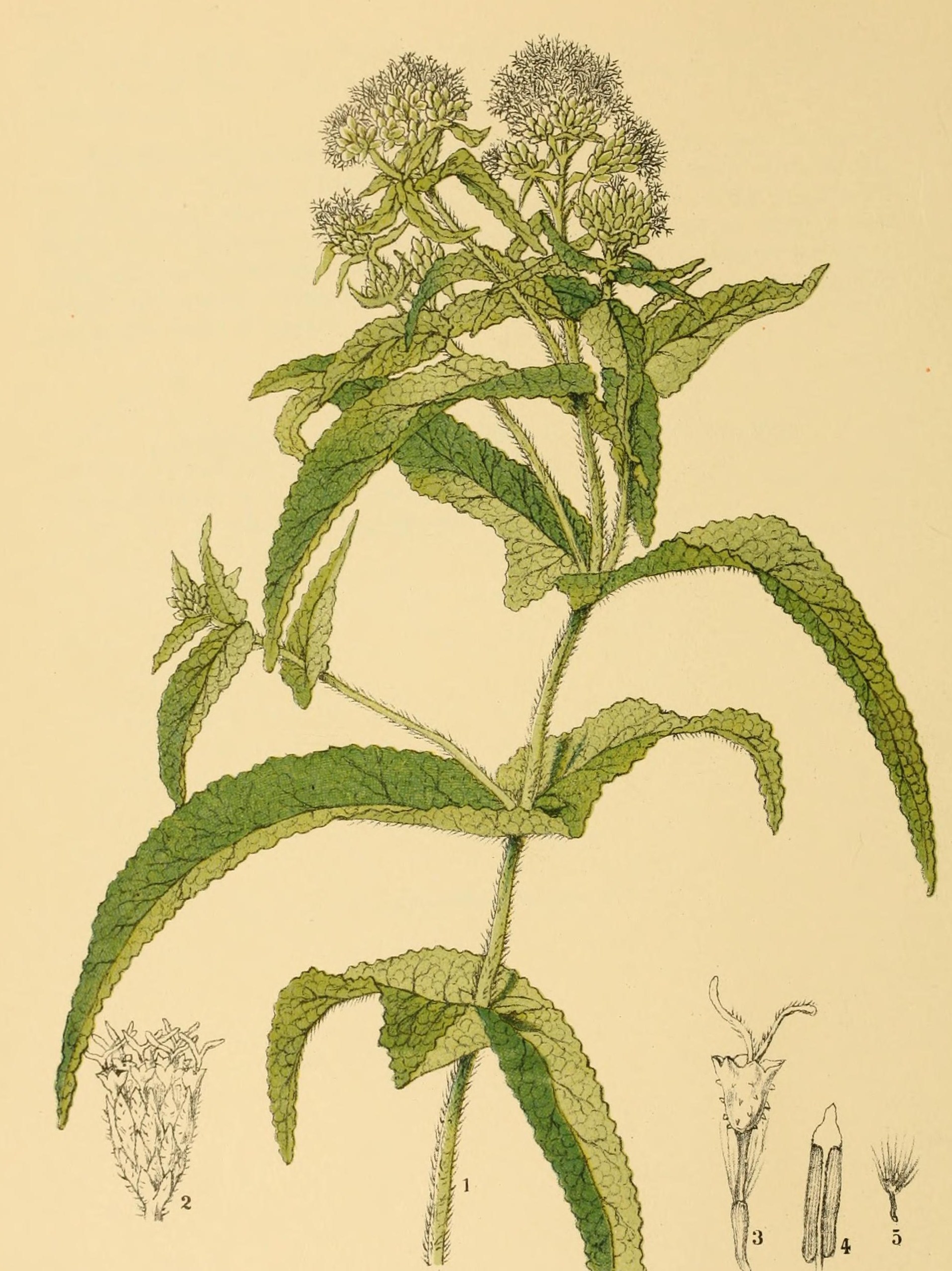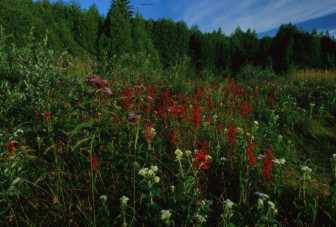
Eupatorium perfoliatum (L)
 Synonyms: thoroughwort, feverwort, ague
weed, crosswort, Indian sage, sweating plant, teasel, vegetable antimony, wood
boneset
Synonyms: thoroughwort, feverwort, ague
weed, crosswort, Indian sage, sweating plant, teasel, vegetable antimony, wood
boneset
Order: Compositae
Description: This perennial herb can reach a height of 1.5m. Its stout, hairy stem bears opposite pointed leaves united at the base so as to seem perforated by the stem. These are finely toothed, rough above, downy and resinous below. The terminal flower clusters are white and reminiscent of yarrow. It grows in damp pastures and wet ground throughout eastern and central North America
Parts used: aerial parts
Collection: As soon as the flowers open in August or September
Constituents: Bitter glycoside (eupatorin), volatile oils containing sesquiterpene lactones, gallic acid, a glucosidal tannin, polysaccharides, flavonoids (including quercetin, kaempferol, eupatorin and rutin), resin
Actions: Diaphoretic, febrifuge, aperient, cathartic, emetic, tonic, antispasmodic, relaxes mucous membranes and peripheral blood vessels, peripheral vasodilator, cholagogue, gentle laxative, expectorant, promotes bile flow
Indications: Influenza, acute bronchitis, naso-pharyngeal catarrh. Specifically indicated in influenza with deep aching, and congestion of the respiratory mucosa.
Therapeutics and Pharmacology: Eupatorium perfoliatum is perhaps the best remedy for the relief of the symptoms that accompany influenza, particularly muscle pain. As well as easing the aches and pains, it will help the body to deal with any fever that is present. It can be used to help clear the upper respiratory tract of mucous congestion. Its mild aperient activity will help clear the body of any build-up of waste and ease constipation. It increases the flow of bile. It may also provide symptomatic relief in the treatment of muscular rheumatism and any conditions exacerbated by damp. Eupatorium perfoliatum has been used to treat skin disease linked to digestive and hepatic disorders and for night sweats. Both the polysaccharides and the sesquiterpene lactones are immunostimulatory in low concentrations; they enhance phagocytosis in vitro. Recent research indicates that the sesquiterpene lactones in the plant and the flavones (especially eupatorin) in both boneset and E. purporeum (gravel root) may have anti-cancer activity.
 Combinations: It may be combined with Achillea,
Sambucus and
Asclepias for influenza.
Combinations: It may be combined with Achillea,
Sambucus and
Asclepias for influenza.
Caution: High doses can cause vomiting.
Preparation and Dosage: (thrice daily)
Regulatory status GSL
Dried herb: 1-2g or by infusion
Liquid Extract: 1:1 in 25% alcohol, 1-2ml
Solid Extract: 0.3-0.5g
Tincture: 1:5 in 45% alcohol, 1-4ml
Additional Comments: This North American herb was of great value to early white settlers who used it to treat a serious flu-like disease called breakbone fever. This led to the name boneset, while the Native Americans called it ague weed. Chinese medicine uses it for summer colds, heatstroke, tightness of the chest, and bad breath. In homeopathy it is prescribed for flu and malaria.
Bibliography
BHMA 1983 British Herbal Pharmacopoeia, BHMA, Bournemouth.
Grieve, M. 1931 A Modern Herbal, (ed. C.F. Leyel 1985), London.
Hoffmann, D. 1990 The New Holistic Herbal, Second Edition, Element, Shaftesbury.
Lust, J. 1990 The Herb Book, Bantam, London.
Mabey, R. (ed.) 1991 The Complete New Herbal, Penguin, London.
Mills, S.Y. 1993 The A-Z of Modern Herbalism, Diamond Books, London.
Ody, P. 1993 The Herb Society's Complete Medicinal Herbal, Dorling Kindersley, London.
Polunin, M. and Robbins, C. 1992 The Natural Pharmacy, Dorling Kindersley, London.
Wren, R.C. 1988 Potter's New Cyclopaedia of Botanical Drugs and Preparations, C.W.Daniel, Saffron Walden.










